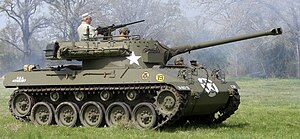
Back M18 Hellcat Czech M18 Hellcat German M18 Hellcat Spanish M18 Hellcat Estonian M18 Hellcat Finnish M18 Hellcat French M18 Hellcat Galician M18 הלקט HE M18 Hellcat Croatian M18 Hellcat Hungarian
| 76 mm Gun Motor Carriage M18 | |
|---|---|
 | |
| Type | Tank destroyer |
| Place of origin | United States |
| Service history | |
| In service | 1943–present[1] |
| Wars | |
| Production history | |
| Designer | United States |
| Designed | 1943 |
| Manufacturer | Buick Motor Division of General Motors |
| Unit cost | US$55,230 (equivalent to $955,928 in 2023)[2] |
| Produced | July 1943—October 1944 |
| No. built | 2,507 |
| Specifications ([7]) | |
| Mass | 37,557 lb (18.779 short tons; 17.036 t) fighting weight, with crew[3] |
| Length |
|
| Width | 9 ft 5 in (2.87 m) |
| Height | 8 ft 5 in (2.57 m) over antiaircraft machine gun |
| Crew | 5 (Commander, gunner, loader, driver, assistant driver) |
| Armor | 4.8–25.4 mm (0.19–1.00 in) |
Main armament | 76 mm gun M1A1, M1A1C, or M1A2 in Mount M1 45 rounds[4] |
Secondary armament | .50 caliber (12.7 mm) Browning M2HB machine gun 800 rounds[4] |
| Engine |
|
| Power/weight | 19.8–22.6 hp (14.8–16.9 kW)/tonne |
| Transmission | 900T Torqmatic automatic transmission 3 speeds forward, 1 reverse |
| Suspension | Torsion bar |
| Fuel capacity | 165 US gal (620 L)[4] |
Operational range | 100 mi (160 km) on road |
| Maximum speed |
|
The M18 Hellcat (officially designated the 76 mm Gun Motor Carriage M18 or M18 GMC) is a tank destroyer used by the United States Army in World War II and the Korean War. Despite being equipped with the same main gun as some variants of the much larger Sherman tank, the M18 attained a much higher top speed of up to 55 mph (89 km/h) by keeping armor to a minimum, and using the innovative Torqmatic automatic transmission.
The M18 Hellcat was the culmination of the development of various prototypes of fast tank destroyers dating back to 1941. Entering production in summer 1943, the M18 first saw combat service in spring 1944. The M18 served primarily in Western Europe, but was also present in smaller numbers in Italy and the Pacific. Production continued until October 1944, with 2,507 built.
The Hellcat was the most effective U.S. tank destroyer of World War II. It had a higher kill-to-loss ratio than any other tank or tank destroyer fielded by U.S. forces in World War II.[8][9] Kills claimed were 526 in total: 498 in Europe, 17 in Italy, and 11 in the Pacific. The kills-to-losses ratio for Europe was 2.3 to 1, and the overall kill to loss ratio was 2.4 to 1.[10] M18s were "...not primarily used for tank fighting, but were committed more often to improvised roles, usually direct fire support for infantry."[11] Although the M18 was retired from U.S. service immediately after the end of World War II, a variant, the M39 Armored Utility Vehicle, served in the Korean War, and M18s continued in service with some countries until 1995.
The M18 Hellcat was an example of the balancing act among firepower, armor, and mobility in armored fighting vehicle design. Despite its excellent mobility and reasonably powerful main gun, the M18 Hellcat also had drawbacks, including thin armor and a poor high explosive shell for its main gun. Historian Steven J. Zaloga characterized the overall design of the M18 as "poorly balanced" and stated that "the Hellcat's combat record is attributable to the training and dedication of its crews, not to its ill-conceived design."[11]
- ^ jwh1975. (2020, February 9). M18 Hellcats in Yugoslavia after WWII / the "Krajina Express". wwiiafterwwii. Retrieved January 5, 2023, from https://wwiiafterwwii.wordpress.com/2020/02/09/m18-hellcats-in-yugoslavia-after-wwii-the-krajina-express/
- ^ Zaloga, 2004 p11
- ^ Cite error: The named reference
TM-9-755-9was invoked but never defined (see the help page). - ^ a b c Cite error: The named reference
TM-9-755-10was invoked but never defined (see the help page). - ^ a b Cite error: The named reference
TM-9-755-179was invoked but never defined (see the help page). - ^ Cite error: The named reference
TM 9-755-43was invoked but never defined (see the help page). - ^ Cite error: The named reference
50megswas invoked but never defined (see the help page). - ^ Cite error: The named reference
Tank Overhaulwas invoked but never defined (see the help page). - ^ Cite error: The named reference
Fox-25was invoked but never defined (see the help page). - ^ Zaloga, 2004 p36
- ^ a b Zaloga, 2004 p37
© MMXXIII Rich X Search. We shall prevail. All rights reserved. Rich X Search